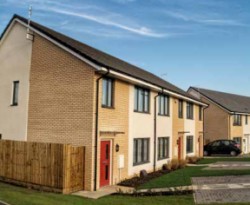As Colin Dalton, Co-Founder and Director at architectural practice Gray Design explains, offsite technology holds many keys to unlocking low-carbon construction for the social housing sector.
In recent years European and UK governments have made commitments to reach net zero and reduce greenhouse gases by mid-century. In May 2019, the Committee on Climate Change (CCC) recommended that the UK should aim to be net zero on all greenhouse gases by 2050. This would keep the UK in line with the 2016 Paris Agreement. In the Paris Agreement, governments agreed to keep global warming below 2°C and to make efforts to keep it to 1.5°C.
Informed by the Paris Agreement, The UK Green Building Council (UKGBC) launched its 'Net Zero Carbon Buildings: A Framework Definition' document in 2019. The document defines what achieving net zero carbon emissions means, in terms of the construction of a building and its operation of it, and how to reduce embodied carbon levels.
The framework sets out definitions around two approaches to net zero carbon buildings. Net Zero Carbon for Construction – when the amount of CO2 associated with a building's product and construction stages up to practical completion is zero or negative, through the use of offsets or the net export of on-site renewable energy. Net Zero Carbon for Operational Energy – when the amount of CO2 associated with the building's operational energy on an annual basis is zero or negative. Why offsite? If the methods of offsite construction are correctly used then the carbon emissions from the manufacturing, transportation and construction phases of a building can be reduced.
Early engagement with offsite construction specialists is key to unlocking environmental transport benefits. This means that solutions are optimised at the design stage of a concept and therefore reducing weight, materials, and volume. With the increasing understanding of offsite construction, supports for M&E services are now becoming modular. These supports can be easily assembled with minimal tools removing waste as they are cut to size, and deliveries to and from the site are reduced because supports can be altered at the source.
Offsite construction is being seen as a way to meet some of the demand for new social housing. Prefabricated housing offers comfortable, well-insulated homes that can be constructed more quickly than traditional buildings. Offsite construction can deliver a modern apartment block in half the time that it would take to build using traditional methods.
Japan faced a housing crisis following WWII and the nation's construction industry couldn't keep up with the demand. Japan solved its crisis which led William Johnson to investigate how they did it in his report titled 'Lessons from Japan: A comparative study of the market drivers for prefabrication in Japanese and UK private housing development'.
The goal was to explore if the UK could learn anything from Japan. Johnson paid specific attention to the use of offsite construction which he claims is a major reason why Japan can build houses faster than the UK. In 2004, of the 1,160,083 houses built in Japan, 159,224 (13.7%) were prefabricated. This means the volume of offsite houses manufactured in Japan in 2004 exceeded that of total new build completions in England for that year.
A more recent example came from a project in Cambridge, where six modular homes were installed on a temporary site to house homeless people. A report by the Cambridge Centre for Housing & Planning Research noted that residents were impressed with the design, space, and quality of the modular units. The Cambridge project is especially relevant to the UK's large number of homeless people. In March 2020, more than 14,000 homeless people were housed in England as part of the 'Everyone In' initiative to take rough sleepers off the streets during the first wave of the COVID-19 pandemic.
It is clear offsite construction can solve a housing crisis but it's important to know which type of housing it is best suited for. High-rise residential buildings seem to be the most popular. Following a thorough investigation outlined in a UK report titled 'Application of Modular Construction in High-Rise Buildings,' it was revealed that when modular construction was used for high-rise buildings it reduced overall construction time by 50%, waste by 70%, and led to an average cost savings of 30% compared to traditional techniques. High-rise buildings are favoured due to its inherently topological modular form and the increased number of repeatable modules. Examples of this type of modular building in the UK include the 249-flat Creekside Wharf development in Greenwich and the 700-bedroom Victoria Hall student accommodation in Wolverhampton.
It was estimated that for the 25-storey modular building in Wolverhampton the total effort in constructing the building was approximately 16 man hours per square metre (1.5 man− hours per square foot) completed floor area, which represents an estimated productivity increase of approximately 80% relative to site-intensive construction. Offsite works Offsite construction for social housing has already proven it can be the solution to the current housing crisis however it requires further government policy development and carrying out multi-residential demonstration projects to further evidence its potential.
It is difficult to fully realise the potential of offsite construction for social housing as there is currently a skills shortage. However, there are organisations that have already committed to solving this. For example, the CITB has invested £1.2million in educational resources for both classroom-based and hands on training to upskill the workforce and improve the UK's capacity for offsite housing construction. There are many different sectors crucial to the success of offsite construction. It is vital that the government and other major industry bodies continue to nurture this growing method of construction, demonstrating a long term commitment to supporting innovative forms of construction and trying to combat the UK housing crisis.
Read the full article, go to Offsite Magazine









